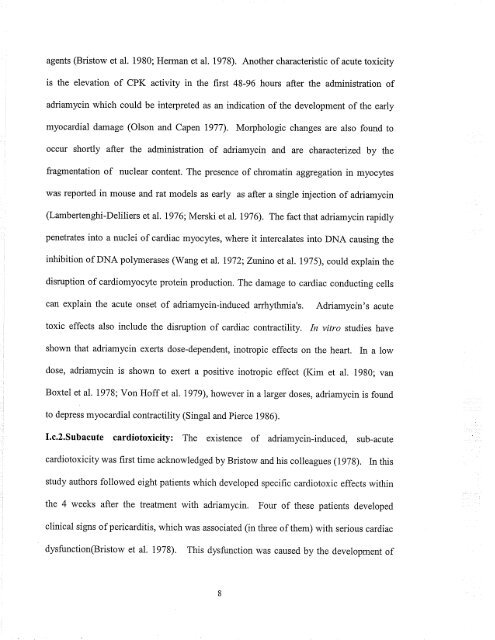il\VOLVEMENT OF RETII\OIC ACID II{ - MSpace at the University of ...
il\VOLVEMENT OF RETII\OIC ACID II{ - MSpace at the University of ...
il\VOLVEMENT OF RETII\OIC ACID II{ - MSpace at the University of ...
You also want an ePaper? Increase the reach of your titles
YUMPU automatically turns print PDFs into web optimized ePapers that Google loves.
agents (Bristow et al. 1980; Herman et al. 1978). Ano<strong>the</strong>r characteristic <strong>of</strong> acute toxicity<br />
is <strong>the</strong> elev<strong>at</strong>ion <strong>of</strong> CPK activity in <strong>the</strong> first 48-96 hours after <strong>the</strong> administr<strong>at</strong>ion <strong>of</strong><br />
adriamycin which could be interpreted as an indic<strong>at</strong>ion <strong>of</strong> <strong>the</strong> development <strong>of</strong> <strong>the</strong> early<br />
myocardial damage (Olson and Capen 1977). Morphologic changes are also found to<br />
occur shortly after <strong>the</strong> administr<strong>at</strong>ion <strong>of</strong> adriamycin and are charactenzed by <strong>the</strong><br />
fragment<strong>at</strong>ion <strong>of</strong> nuclear content. The presence <strong>of</strong> chrom<strong>at</strong>in aggreg<strong>at</strong>ion in myocytes<br />
was reported in mouse and r<strong>at</strong> models as early as after a single injection <strong>of</strong> adriamycin<br />
(Lambertenghi-Deliliers et a|. 1976; Merski et aL 1976). The fact th<strong>at</strong> adriamycin rapidly<br />
penetr<strong>at</strong>es into a nuclei <strong>of</strong> cardiac myocytes, where it intercal<strong>at</strong>es into DNA causing <strong>the</strong><br />
inhibition <strong>of</strong> DNA polymerases (Wang et al. 1972; Zunino et al. 1975), could explain <strong>the</strong><br />
disruption <strong>of</strong> cardiomyocyte protein production. The damage to cardiac conducting cells<br />
can explain <strong>the</strong> acute onset <strong>of</strong> adriamycin-induced arrhythmia's. Adriamycin's acute<br />
toxic effects also include <strong>the</strong> disruption <strong>of</strong> cardiac contractility. In vitro studies have<br />
shown th<strong>at</strong> adriamycin exerts dose-dependent, inotropic effects on <strong>the</strong> heart. In a low<br />
dose, adriamycin is shown to exert a positive inotropic effect (Kim et al. 1980; van<br />
Boxtel et al. 1978; Von H<strong>of</strong>f et aL. 1979), however in a larger doses, adriamycin is found<br />
to depress myocardial contractility (Singal and pierce l986).<br />
I.c.2.Subacute cardiotoxicity: The existence <strong>of</strong> adriamycin-induced, sub-acute<br />
cardiotoxicity was first time acknowledged by Bristow and his colleagues (1978). In this<br />
study authors followed eight p<strong>at</strong>ients which developed specific cardiotoxic effects within<br />
<strong>the</strong> 4 weeks after <strong>the</strong> tre<strong>at</strong>ment with adriamycin. Four <strong>of</strong> <strong>the</strong>se p<strong>at</strong>ients developed<br />
clinical signs <strong>of</strong> pericarditis, which was associ<strong>at</strong>ed (in three <strong>of</strong> <strong>the</strong>m) with serious cardiac<br />
dysfunction(Bristow et al. T978). This dysfunction was caused by <strong>the</strong> developme¡t <strong>of</strong>







![an unusual bacterial isolate from in partial fulf]lment for the ... - MSpace](https://img.yumpu.com/21942008/1/190x245/an-unusual-bacterial-isolate-from-in-partial-fulflment-for-the-mspace.jpg?quality=85)





![in partial fulfil]ment of the - MSpace - University of Manitoba](https://img.yumpu.com/21941988/1/190x245/in-partial-fulfilment-of-the-mspace-university-of-manitoba.jpg?quality=85)


